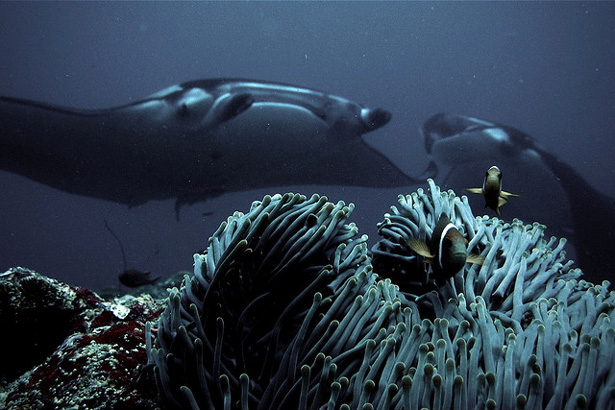-
State of the Oceans 2013: Acidification, Overfishing Major Threats to Ecosystem Health
February 3, 2014 By Sean R. Tracy
“The rate of speed of change in the global oceans are greater than [that] of any time in known history,” said Karen Sack of the Pew Charitable Trusts, speaking at the Wilson Center on November 13. She was joined by Paul Schopf, professor of oceanography and associate dean for research and computing at George Mason University, and Libby Jewett, director of the Ocean Acidification Programs at National Oceanic and Atmospheric Administration (NOAA), to discuss the latest State of the Ocean Report. [Video Below]
The event was part of the “Managing Our Planet” seminar series, cosponsored by George Mason University and the Wilson Center’s Brazil Institute and Environmental Change and Security Program. Moderated by Dann Sklarew of George Mason University, it was framed through the lens of the “Planet 2.0” concept, a way of describing emerging conservation methods that suggests societies have overexploited “Planet 1.0” and it is time to move on to the next phase of the human-environment relationship.
Acidification Monitoring
Not only has the ocean absorbed an estimated 93 percent of the heat generated by climate change, but according to the report, it is absorbing a significant portion of atmospheric CO2. Between 1750 and 2011, 545 gigatons of CO2 were released into the atmosphere, said Jewett. About one third of that (155 gigatons) have gone into the oceans. But the ocean can no longer be relied on to buffer CO2 emissions, she said, having already increased in acidity by 30 percent, a level beyond any measured in recent history. Higher concentrations of atmospheric and oceanic carbon dioxide interfere with the carbonate systems of the ocean life, primarily with organisms that use carbonate ions to build their shells, like shellfish. The immediate effect will be decreased species diversity, but the long-term impact on marine wildlife is unknown. One recent study even suggests high CO2 levels could have neurological and behavioral effects on fish.
The Federal Ocean Acidification Research and Monitoring Act of 2009 focused U.S. government efforts on interdisciplinary research, long-term monitoring, and outreach opportunities around ocean acidification. Jewett said a combination of regional and local factors, such as runoff, can exacerbate conditions, and sampling along coastlines can be highly variable and difficult to monitor due to seasonal variations, but there is a global need to improve on such efforts. NOAA has focused on monitoring federally managed species, such as Alaskan king crab and summer flounder. Many western U.S. fisheries have been better at monitoring acidification effects on fisheries, and NOAA is currently in the process of putting together a northeast coastal acidification network for monitoring in the Atlantic.
Unknown Consequences
Karen Sack complimented these efforts, saying we are in a race to safeguard the ocean and need to continue to look for ways to mitigate immediate stressors to ocean ecology. She pointed to not only increased acidity and temperature, but also decreased O2, more particulate plastics, and the spread of so-called “dead zones,” areas where hazardous pollutants have been carried downstream killing off or damaging aquatic communities in the process. Acidification, warming, and deoxygenation all yield cascading consequences, such as inhibited productivity, altered food chains, changes in nutrient supply, and secondary and tertiary changes to ocean chemistry. These consequences will, in turn, be passed on to the billions of people that rely on the sea for their food and livelihoods.
Despite the overwhelming focus on changing ocean chemistry, the number one issue impacting the health of the oceans is still overfishing, said Sack. There are currently 1.3 million commercial fishing vessels worldwide that annually remove 87 million tons of fish and invertebrates essential to functioning ecosystems, she continued; illegal and unreported fishing may make up as much as 20 percent of that catch, with some vessels going as far as to change names and home flags to hunt under different names. At current rates of take, some predict the global commercial fishing industry could collapse by 2050 – a threat not only to biodiversity but global food security. The United Nations Convention on the Law of the Sea (UNCLOS) was adopted by most developed nations and can provide a framework for addressing fishing quotas, but has not been accepted by all (including the United States), and enforcement remains a major challenge, regardless.
Global Solutions for a Global Problem
A global paradigm shift is in order, the speakers agreed. Better multi-sector, regional and global ecosystems management is needed to prevent collapse and reverse species declines. Sack suggested UNCLOS, originally drafted in 1982, should be updated and for there to be a new push for global leaders to ratify the document. Improved technology could strengthen monitoring and enforcement of treaties, the panel said, making them more effective. Interpol, for example, has launched a new unit called Project Scale devoted to detecting and preventing illegal fishing.
“We have to shift what we are doing in order to recognize that the carrying capacity has shifted,” said Sack. Previous management policies have led to overexploitation and, consequently, failing ecosystems. This is the challenge presented by the Planet 2.0 concept; as a global society, we need to decide how to respond to current environmental challenges and move forward for a better tomorrow.
Event Resources:
Sean R. Tracy is an environmental educator and a PhD student in George Mason University’s School of Environmental Science and Public Policy.
Sources: Integrated Ocean Observing System, International Program on the State of the Ocean, Interpol, PLOS ONE, U.S. National Oceanic and Atmospheric Administration, UN.
Photo Credit: “Lankan Manta Point,” courtesy of flickr user Hani Amir.
 A Publication of the Stimson Center.
A Publication of the Stimson Center.



